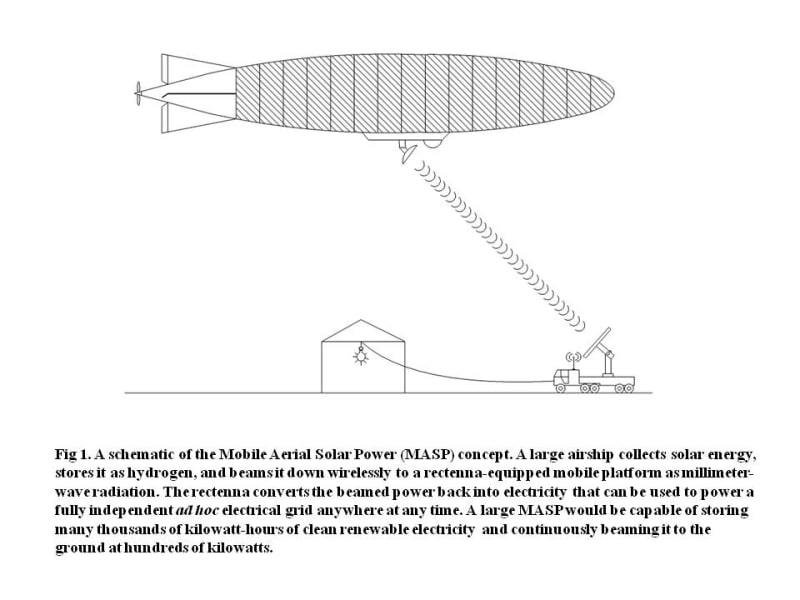This is a design for a mobile aerial solar power plant (MASP) that uses the large surface area and heavy lifting capabilities of a remote-piloted airship to provide a platform for the collection, storage, and wireless delivery of solar-derived energy to a rectenna unit capable of powering an ad hoc electrical power grid on the ground.
The entire surface of the airship is covered with thin-film photovoltaics to maximize harvesting of sunlight including diffuse sunlight and albedo from the earth’s surface. The electricity so generated is apportioned by a smart power management system to the airship’s propulsion system, energy storage system, and power beaming system.
The energy storage system is comprised of a stack of regenerative fuel cells capable of being operated in reverse to electrolyze water to generate hydrogen gas that is used as an energy storage medium. The hydrogen gas is simply stored in the lifting gas cells of the airship to provide buoyancy in addition to storing energy. When the energy needs to be recovered from storage, the hydrogen would be pumped back into the fuel cell stack along with ambient air to regenerate the electricity.
The energy beaming system is comprised of one or more gyrotrons that are capable of using DC electricity to generate coherent electromagnetic beams in the microwave and millimeter wavelengths. The ideal wavelength would be 95 GHz as the U.S. military has determined that this wavelength does not penetrate deeply into tissues and so would operate as a safety mechanism for ground crew. Alternatively the 95 GHz beam could be used as a painful but otherwise harmless deterrent to looting or other crimes similar to its use by the military’s active denial system.
The power beam would be intercepted by a rectenna that is attached to a mobile platform such as a vehicle or towed trailer. The rectenna would convert the electromagnetic beam back into electricity and distribute it to the various client applications needing electricity on the ground.
Applications envisioned for the MASP include but are not limited to providing electrical power and security for disaster recovery operations, refugee camps, military forward operating bases, hydrocarbon exploration and other scientific expeditions to remote locations, outdoor entertainment venues such as Burning Man, and grid independence for ranches, farms, or wealthy neighborhoods. Smaller versions of the MASP might even have application as atmospheric probes for the exploration of other planets.
The MASP should be fairly straightforward to construct and manufacture as airships were a mature technology over a century ago and most of the other components can be purchased directly from vendors in an almost off-the-shelf fashion. While initially costly to develop, it is projected that the maturing of the component renewable energy technologies and rising cost of hydrocarbon fuels will result in increasing cost-effectiveness as time goes on.
Like this entry?
-
About the Entrant
- Name:Stuart Laforge
- Type of entry:individual
- Software used for this entry:Powerpoint & Google Sketchup
- Patent status:pending








